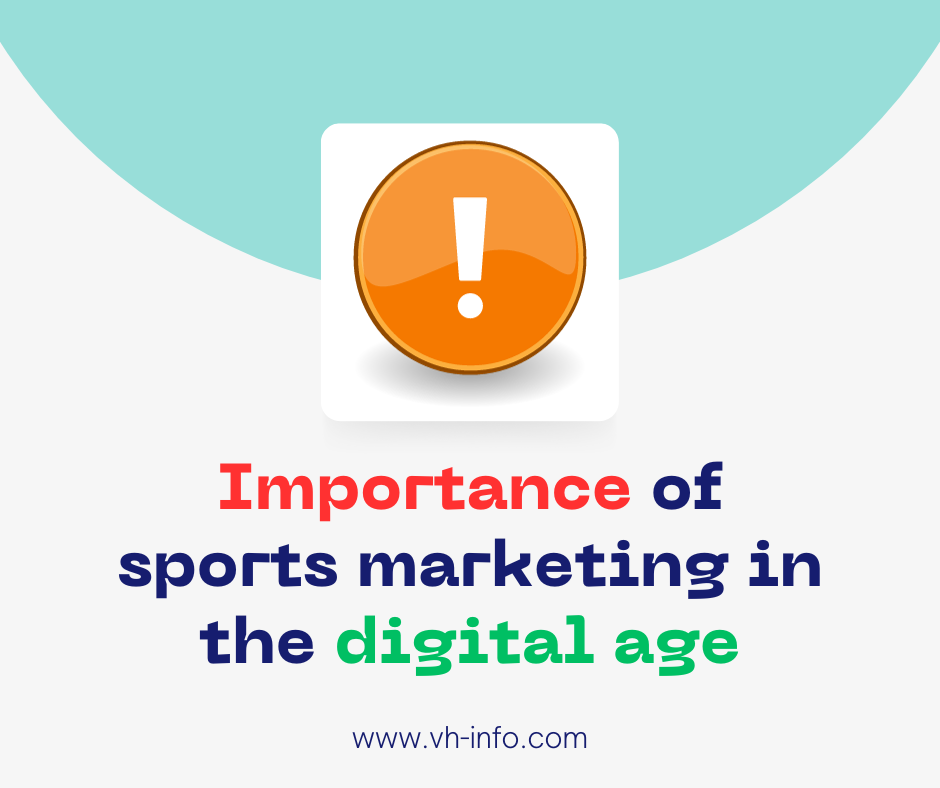Sports Marketing is a dynamic and growing field that uses marketing principles to promote sports events, organizations, and products. With the ever-increasing popularity of sports among people globally, it has become an essential aspect of the sports industry.
In this blog, VH-info will cover everything you need to know about Sports Marketing – from defining what it is, why it matters, and how it works in a digital age to exploring different types of Sports Marketing Strategies.
We will also take a look at some of the best Sports Marketing Campaign Examples that have made an impact on audiences worldwide and how they affect the success of sports business.
So whether you are a marketer looking for new ways to reach your target audience or just an avid fan interested in learning more about this fascinating field, keep reading!
What Is Sports Marketing?
Sports marketing involves the promotion of sports events, activities, people, sporting events, or team products and services through advertising, sponsorships, merchandise sales, and PR. Its goal is to increase attendance, viewership, sales, and fandom by generating interest and excitement.
Sports marketers connect teams and athletes with fans and consumers, including those in professional sports. They help build brands, sell tickets/merchandise, secure sponsorships, and promote games/events. Effective sports marketing creates a fanbase and grows revenues while building a brand reputation.
What is a Sports Marketing Mix?
The sports marketing mix refers to the set of controllable marketing tools that sports organizations use to promote their teams, athletes, and events to fans and generate revenue. It consists of the 4 Ps of marketing adapted to the sports industry – Product, Price, Place, and Promotion:
- The product is the sports entertainment experience itself that fans consume.
- Price covers things like ticket sales, merchandise, concessions, and broadcasting rights.
- Place refers to how fans access sports content through live games, broadcasts, websites, and more.
- Promotion includes advertising, social media, PR, partnerships, signage, and other communication tools.
In the first case, an effective sports marketing mix blends these elements to attract fans, drive ticket sales and merchandise purchases, secure sponsorships, grow television audiences, and maximize revenues from sports properties and athletes.
Why Does Sports Marketing Matter?
Sports marketing matters because it is critical for sports teams, professional leagues, and athletes to connect with fans and generate revenue. Effective sports marketing creates awareness, interest, and demand for sports entertainment.
It helps build fanbases, sell tickets and merchandise, secure sponsor partners, attract advertisers, drive TV viewership, and fuel overall revenues.
Sports marketing enables teams and athletes to build strong brands that fans are passionate about. This generates fan loyalty, high attendance, prime media deals, and lucrative sponsorships. In addition, sports marketing promotes fitness and an active lifestyle to the general public.
It provides entertainment and a sense of cultural identity for fans. Overall, sports marketing matters because it allows the massive sports industry to thrive and grow commercially while providing entertainment that captivates millions of people globally.
Importance of sports marketing in the digital age

Here are some key points on the importance of sports marketing in the digital age:
- Allows direct engagement with fans through social media and digital platforms
- Enables data-driven targeted marketing based on detailed analytics and fan preferences
- Provides new revenue streams through media rights deals with streaming services
- Creates personalized, enhanced game-day experiences using mobile apps and technology
- Builds loyal fan communities and brand advocacy through digital engagement
- Measures marketing effectiveness using digital metrics and analytics
- Serves fans with on-demand sports highlight and analysis content
- Redistributes sports content globally through digital channels
- Keeps brands relevant through constant digital interaction and campaigns
- Allows smaller sports leagues and teams to build profiles and monetize content
Digital trends in sports marketing
Now, organizations have a chance to do some really cool stuff to make fans like them more and like their athletes more. They can use things like social media, making their websites work better on phones, and using videos to make this happen. This is all about the new and fun things happening in the future of sports marketing on the internet.
Social media marketing
Social media has become a critical platform for sports teams and athletes to directly engage with fans. Platforms like Facebook, Instagram, Twitter, and TikTok allow brands to share content, run campaigns, organize contests, and enable fans to connect as online communities on social media platforms.
Sports brands leverage these platforms to give fans behind-the-scenes access, promote merchandise and tickets, conduct Q&As, and capture user-generated content. The real-time, two-way nature of social media provides sports marketers with an effective channel to build lasting relationships with fans through their social channels.
Mobile Optimization
With the significant growth in mobile usage, sports brands are optimizing their marketing and content delivery for mobile platforms. This includes developing feature-rich mobile apps and mobile-friendly websites that allow fans to access content, buy tickets, play games, receive notifications, and more.
Sports teams are also creating mobile-first video content that is designed for on-the-go viewers. Location-based tools like maps and GPS further enhance engagement. Overall, mobile optimization enables sports brands to tap into always-connected fan bases and drive revenue through mobile commerce.
Video Marketing
Video has emerged as a highly engaging sports marketing tool given its ability to capture emotions and provide immersive experiences for fans. Sports teams are actively promoting video content across social media, websites, and OTT platforms.
This includes highlights, behind-the-scenes footage, interviews, live streaming, and user-generated videos. Sports video marketing is focused on storytelling by combining analytics and creativity. Short-form vertical videos cater perfectly to mobile users. Overall, video provides interactive and shareable experiences between fans and sports brands.
How Is A Sports Marketing Plan Developed?

Creating a sports marketing plan is a crucial step in making sure that marketing efforts are successful.
Here’s how it’s done:
- Start with Key Questions: The first step is to answer some important questions, like how much money you can spend and what resources you have. This is because sports marketing can be expensive, so you need to use your resources wisely. You also need to decide how long your marketing campaign will run – for a short time, a whole season, or several years.
- Understand Your Product and Audience: You need to analyze your product and understand your target audience. This means knowing what your customers want and need. The sports marketing world is always changing, so you need to do market research to find the best opportunities.
- Deploying Marketing Managers for Business Growth: Once you have a plan, you’ll need a team of creative sports marketing professionals, a marketing manager, and an event coordinator. They will work on creating ads to promote your products, which can be on TV, social media, billboards, or radio. These ads should reflect the goals you set in your plan and use sports-related elements like team colors, slogans, and sports imagery.
- Measure Effectiveness: Once your marketing campaign starts, it’s essential to monitor its effectiveness. You can look at metrics like increased sales, more Twitter followers, and higher brand awareness to see how well your campaign is doing. If these numbers match the goals you set in your plan, you can continue and even strengthen your campaign. But if the numbers fall short, it may be time to revise your marketing strategy.
Types of Sport Marketing

Marketing of Sports
This involves the promotion and commercialization of sports leagues, teams, and events to generate interest and revenues. Sports entities market themselves through advertising, merchandising, public relations, ticket sales, and brand partnerships. The goal is to build fanbases, maximize viewership of games, increase merch sales, drive ticket purchases, and leverage the sports brand. Marketing campaigns, partnerships, digital content, urban elements, and fan engagement initiatives help establish an emotional connection with fans and promote the success of sports associations.
Marketing Through Sports
This refers to brands leveraging sports leagues, athletes, and events as a marketing channel to reach audiences. Companies sponsor major sports leagues/teams to gain visibility for their brand. Athlete endorsements are used to establish credibility and increase brand awareness. The use of sporting events and stadium advertising also offer exposure to captive audiences. The massive reach and influence of sports provide brands with an effective platform to engage consumers without interruptions, in a high-emotion environment with different products.
Grassroots Sports Marketing
This targets promotion at the local community level to boost participation and support for youth sports, amateur leagues, college athletics, and minor leagues. It focuses on community-based platforms like local media, promotional events, partnerships with recreation centers, endorsements by local athletes/coaches, and outreach initiatives.
The goal is to nurture local talent, increase grassroots participation, deliver positive health outcomes for the community, and establish strong emotional connections with local fans by emphasizing that there is no right way to get active.
Sports Marketing Strategies

Develop a Target Audience
Sports teams need to deeply understand their fans to create relevant messaging and experiences. Conducting market research to analyze the demographics, psychographics, interests, motivations, and pain points of fans is crucial.
This knowledge helps segment audiences and tailor promotions. It also enables personalized engagement through social media, email, etc. Defining clear audience personas is the foundation of an impactful strategy.
Create Engaging Content
Sports brands need a content strategy that leverages video, social media, influencers, and storytelling. The content should educate, entertain, and inspire fans through content marketing. Behind-the-scenes footage, player interviews, and user-generated content on social media create a unique experience. Video series, podcasts, and blogs that provide analysis also keep fans engaged. Content platforms like team apps and OTT further distribution. The key is creating engaging content that resonates with target audiences.
Create Brand Partnerships
Strategic brand sponsorships extend the reach and exposure of sports organizations. Partnerships with non-competing brands that align values and objectives can unlock shared value.
Co-branded promotions, licensing merchandise, integrated advertising, and hospitality opportunities provide additional revenue streams. Partnerships add credibility and allow brands to leverage each other’s customer bases.
Select the Right Distribution Tools
Sports entities need to identify the right mix of digital platforms, traditional media and physical venues to effectively engage fans. Digital tools like social media, streaming, emails and apps provide targeted distribution, while TV, radio and print offer broader reach. Distribution in stadiums through signage and activations also connect with captive audiences. Optimizing across channels is vital.
Challenges for sports marketing campaigns in a digital age

Here is an overview of some key challenges for sports marketing campaigns in the digital age:
- Difficult to cut through the noise and capture consumer attention
- Social media breeds comparisons between sports brands vying for fans
- Need for constant content creation and real-time interaction
- Expectations for exclusivity and behind-the-scenes access
- Privacy concerns around data collection and targeted advertising
- Rapidly changing trends and consumer preferences
- Pressure to demonstrate clear ROI on digital spends
- Piracy threats impacting broadcast rights and sponsorship revenue
- Globalization resulting in varying cultural nuances and languages
- Regulatory issues around copyright, ambush marketing, etc.
- Rising costs of leveraging new technologies like VR and AR
- Shorter consumer attention spans fueled by always-connected devices
- Athlete controversies getting amplified through viral effect
- Authenticity and transparency becoming imperative in messaging
- Balancing traditional and digital marketing strategies and budgets
Marketing products through sports

Sponsorship of events
Brands can sponsor major sporting events like the FIFA World Cup, Olympics, Wimbledon, Super Bowl, and other global events such as the Football World Cup and the Olympic Games, to gain mass awareness. Stadium advertising and logo placement on uniforms/equipment and supplies enable brand visibility to live and broadcast audiences.
On-site activations and exclusivity in categories like beverages, electronics, etc. allow deeper exposure. It delivers a share of voice and provides hospitality opportunities for brand building.
Sponsorship of Teams
In sports marketing, brands are associated with the excitement of sports by sponsoring leagues, teams, or venues. They can use jersey sponsorships, stadium signage, and partnerships to help visibility and build brand loyalty. This also gives them clout and an exclusive partnership advantage. Brands can leverage fan affinity using supply partnerships and merchandise branding.
Additionally, hospitality helps to build connections with fans while enabling year-long visibility aligned with team brands.
Sponsorship of Athletes
In sports marketing, brands use athletes as ambassadors to influence consumers. Famous athletes are role models for youth and have traits like dedication, integrity, and perseverance that transfer to brands. Partnerships can be enhanced by customized equipment, experiential activations, and licensing athlete image/footage. This inspirational factor of favorite athletes cuts through the marketing clutter.
The Best Sports Marketing Campaign Examples

- Puma: Pelé and the Pause – In 1970, Puma created an iconic photo of soccer legend Pelé stopping a ball in mid-air, showcasing their shoe. This innovative creative highlighted Puma’s pivot to performance sportswear.
- Sport England: This Girl Can – Empowering campaign targeting women with inclusive images and messages to get active and shift exercise perceptions.
- Procter & Gamble: Thank You, Mom – Emotional campaigns for multiple Olympics showing moms supporting athletes through heartfelt stories.
- Seattle Seahawks and Starbucks – Local partnership promoted community pride and engagement through co-branded stores, products, and merchandise.
- Chicago Blackhawks: What’s Your Goal? – Digital campaign inviting fans to submit personal goal videos for motivation, driving engagement.
- Nike x Serena Williams: Dream Crazier – This inspiring ad narrated by Serena is about breaking barriers and accomplishing the impossible.
- Adidas – Impossible Is Nothing – Campaign with celebrities and athletes overcoming challenges aligned with Adidas’ brand attitude.
- Reebok: Subway Pump Battle – Guerrilla marketing through impromptu dance battle on a subway highlighting their shoe.
- Red Bull – Stratos – Epic content event of Felix Baumgartner’s record space jump watched by millions worldwide.
- Star Sports: Mauka Mauka – Rivalry ads before India-Pakistan cricket matches with humor, emotion, and local insight.
- Under Armour: Rule Yourself – Showcasing underdog athletes defying limitations to emphasize their ‘fight‘ mentality.
- Gatorade: Be Like Mike – Popular ads leveraging Michael Jordan’s superstardom to fuel aspiration and sales.
- Unibet – Value Stats – Real-time social media content reacting to matches for engagement before betting.
- Paddy Power and social media – Increased brand interaction through irreverent, humorous social media reels & posts true to the brand.
- World Cup 2010: “Waka Waka” by Shakira x Freshlyground – A hugely popular anthem that drove visibility and local collaboration.
FAQ’s:
How is the economy impacted by sports marketing?
Sports marketing is important in many ways. It helps generate money, create jobs, and promote tourism. Brands use sports to reach a large audience and sell more products. This makes the sports industry very valuable for local, national, and global economies. The sports economy is worth billions of dollars and marketing plays a big part in making it successful.
How has technology impacted the field of sports marketing?
Sports marketing has changed with technology. Fans can now interact through social media and mobile devices. Advertisements can target specific consumers using data analytics. Broadcasting rights and streaming have made revenue while expanding global reach. Augmented reality gives an immersive in-venue experience, including the ability to virtually try on team merchandise and bolster the fan experience. Technology allows for personalized and measurable sports marketing across digital channels.
Conclusion
In conclusion, sports marketing plays a crucial role in promoting and growing businesses in the sports industry.
With the rise of digitalization, it has become essential for sports marketers to adapt to new trends and technologies to effectively reach their target audience.
However, there are challenges that come with the digital age, and marketers must navigate them to ensure successful campaigns. Overall, sports marketing offers immense opportunities for brands to connect with consumers and create memorable experiences.

